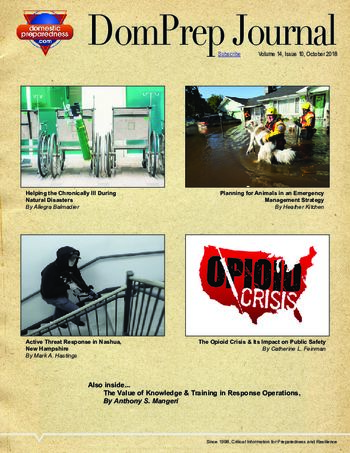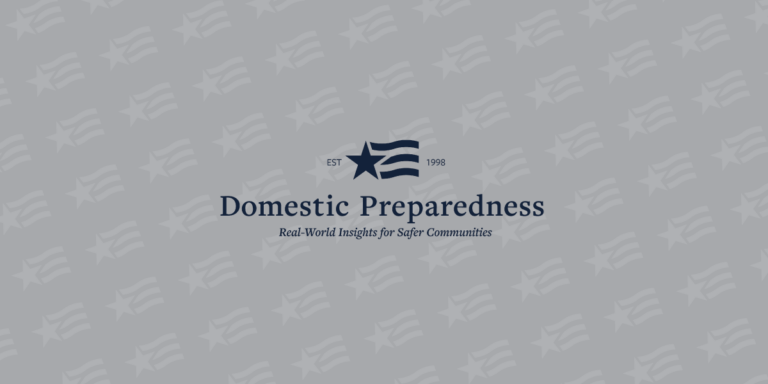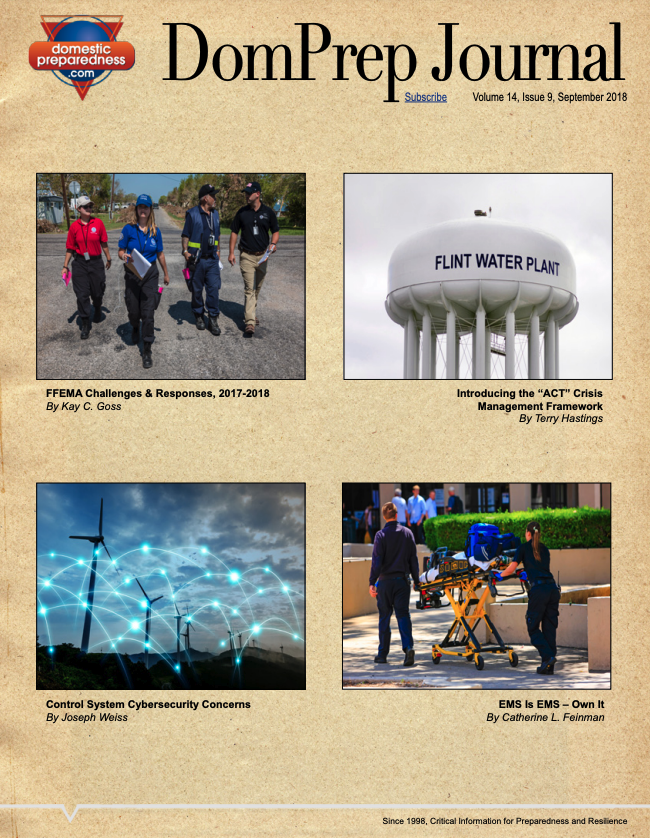
Author Archive

Featured in this issue: Modern Responses to Today’s Disasters, By Catherine L. Feinman; Helping the Chronically Ill During Natural Disasters, By Allegra Balmadier; Planning for Animals in an Emergency Management Strategy, By Heather Kitchen; Special Edition: School Security; Active Threat Response in Nashua, New Hampshire, By Mark A. Hastings; The

Opioid Crisis: Status of Public Health Emergency Authorities
Domestic Preparedness
October 28, 2018
The U.S. Government Accountability Office was asked to review the decision to declare a public health emergency for the opioid crisis and what actions have been taken under the declaration. This report describes: (1) the factors HHS indicated as affecting its decision to declare and renew the public health emergency

Opioid Crisis: Status of Public Health Emergency Authorities
Domestic Preparedness
October 28, 2018
The U.S. Government Accountability Office was asked to review the decision to declare a public health emergency for the opioid crisis and what actions have been taken under the declaration. This report describes: (1) the factors HHS indicated as affecting its decision to declare and renew the public health emergency

September 2018
Domestic Preparedness
September 30, 2018
Featured in this issue: September – A Busy Month of Preparedness, By Martin Masiuk; FEMA Challenges & Responses, 2017-2018, By Kay C. Goss; Introducing the “ACT” Crisis Management Framework, By Terry Hastings; Control System Cybersecurity Concerns, By Joseph Weiss; EMS Is EMS – Own It, By Catherine L. Feinman

Public Health Surveillance: Preparing for the Future
Domestic Preparedness
September 22, 2018
The Center for Disease Control and Prevention’s (CDC) goal for federally supported surveillance activities is to get the right information into the right hands at the right time. A strategic plan to improve surveillance at the CDC was launched in February 2014 to better achieve this goal. This report is

Public Health Surveillance: Preparing for the Future
Domestic Preparedness
September 22, 2018
The Center for Disease Control and Prevention’s (CDC) goal for federally supported surveillance activities is to get the right information into the right hands at the right time. A strategic plan to improve surveillance at the CDC was launched in February 2014 to better achieve this goal. This report is

Homeland Security National Risk Characterization – Risk Assessment Methodology
Domestic Preparedness
September 20, 2018
In 2016, the U.S. Department of Homeland Security, Office of Policy– Strategy, Plans, Analysis, and Risk, asked the RAND National Defense Research Institute to design and implement a risk identification and characterization of natural and manmade threats and hazards to identify the greatest risks to homeland security and support prioritization

Homeland Security National Risk Characterization – Risk Assessment Methodology
Domestic Preparedness
September 20, 2018
In 2016, the U.S. Department of Homeland Security, Office of Policy– Strategy, Plans, Analysis, and Risk, asked the RAND National Defense Research Institute to design and implement a risk identification and characterization of natural and manmade threats and hazards to identify the greatest risks to homeland security and support prioritization

National Biodefense Strategy 2018
Domestic Preparedness
September 19, 2018
The National Biodefense Strategy sets the course for the United States to combat the serious biothreats the country faces. The strategy provides the following: enables risk awareness to inform decision-making across the biodefense enterprise; ensures biodefense enterprise capabilities to prevent bio-incidents; strives for biodefense enterprise preparedness to reduce the impacts

National Biodefense Strategy 2018
Domestic Preparedness
September 19, 2018
The National Biodefense Strategy sets the course for the United States to combat the serious biothreats the country faces. The strategy provides the following: enables risk awareness to inform decision-making across the biodefense enterprise; ensures biodefense enterprise capabilities to prevent bio-incidents; strives for biodefense enterprise preparedness to reduce the impacts
Follow Us
Get Instant Access
Subscribe today to Domestic Preparedness and get real-world insights for safer communities.
ARchives
Article Out Loud – Reduce Burnout & Increase Retention in Emergency Management
August 10, 2022
Emergency management professionals are regularly tasked with high-stress responsibilities, including political pressure, life safety concerns, vulnerable infrastructure, and community vulnerabilities. Three ways to reduce the risk of burnout and increase retention efforts are described in this article: lead with care, invest in psychological support, and look at the schedule.
Article Out Loud – Healthcare Reform: Major Effects on Hospital Preparedness
August 9, 2022
No matter what the Supreme Court decides on the constitutionality of the healthcare reform act, U.S. hospitals must prepare now for major changes in their planning, everyday operations, and both budgetary and personnel resources.
Article Out Loud – Incident Command for Natural Disasters: A Natural Fit
August 9, 2022
The United States already has a national system in place that can help responders “manage” any disaster situation – both natural and manmade. By adapting and modifying the concepts and processes of the Incident Command System, large and small jurisdictions alike can easily incorporate several categories of specialized response teams
Article Out Loud – Responding Respectfully to People With Disabilities
August 3, 2022
Emergency preparedness often involves preparing for a particular type of disaster. However, each disaster can affect people differently depending on their individual physical and mental abilities. This article helps emergency preparedness and response professionals address the needs of individuals with disabilities
Article Out Loud – Wanted: Mental Health Support for Disaster Trauma
August 3, 2022
Disasters are often described in terms of the physical damages they incur. However, the significant impact on mental health, which can have even longer-term consequences, sometimes is not addressed until after the response phase of the disaster is complete.
Article Out Loud – Special Facilities – More Than Just Shelters
August 2, 2022
Emergency managers are tasked with creating disaster plans to protect the people within their jurisdictions. With numerous possible scenarios, any disaster may require the establishment of special facilities to provide sheltering, vaccinations, and other emergency services to the public.
Article Out Loud – The Continuity Gap
August 2, 2022
This 2016 article describes a continuity gap that still exists today in many corporations. Corporate confusion could spell disastrous response in a crisis. To dispel such confusion, companies should have an emergency manager on staff, ensure that employees are well prepared
Article Out Loud – Societal Violence & Its Impact on Critical Infrastructure
July 27, 2022
An examination of past violence shows how terminology can affect the incident-reporting process and subsequent statistics for various incident rates. However, statistics clearly show that the COVID-19 pandemic did increase societal violence, which can significantly impact critical infrastructure.
Article Out Loud – Creating a Common Operating Picture for Wildfire Season
July 27, 2022
An Article Out Loud from the Domestic Preparedness Journal. Life is beginning to return to normal following the past two years of the pandemic, but the world is still as unpredictable as ever. When it seems as though one catastrophic situation is coming to an end, another tends to emerge
Article Out Loud – Teleforensic Tools – From Telemedicine to Law Enforcement
July 20, 2022
Telemedicine capabilities have become valuable medical tools to provide life-saving treatment to patients where and when needed. Similarly, off-site skills and knowledge can be transferred to on-site law enforcement personnel through teleforensics to identify and thwart threats, while increasing crime clearances.
Follow Us
Get Instant Access
Subscribe today to Domestic Preparedness and get real-world insights for safer communities.


